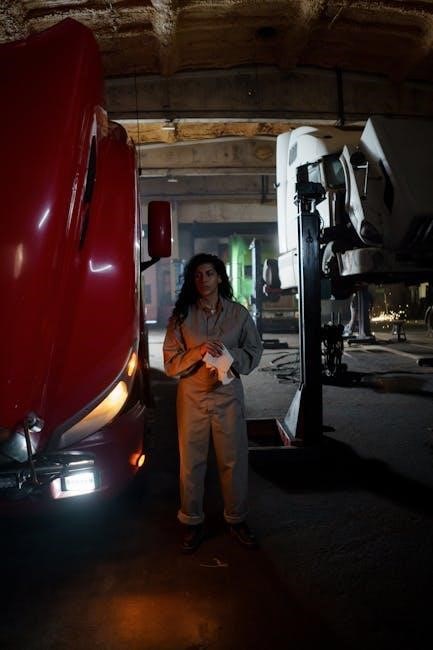
Chinese diesel heater manuals provide essential guidance for installation, operation, and maintenance. These PDF documents are readily available online, offering detailed instructions for safe and efficient use.
Overview of Chinese Diesel Heaters
Chinese diesel heaters are compact, efficient heating solutions designed for vehicles, boats, and small spaces. They operate on diesel or gasoline, offering reliable warmth in cold conditions. These heaters are known for their portability, low fuel consumption, and ease of installation. Many models feature automatic and manual control modes, allowing users to adjust settings for optimal performance. Safety features, such as overheating protection and fault alarms, are standard. Popular among outdoor enthusiasts, these heaters are widely used in RVs, trucks, and camping setups due to their durability and versatility. They also comply with environmental standards, ensuring eco-friendly operation.
Importance of Using a Manual
Using a manual for Chinese diesel heaters is crucial for safe and effective operation. It provides detailed instructions for installation, maintenance, and troubleshooting, ensuring users understand proper setup and usage. The manual outlines essential safety precautions, such as avoiding flammable materials and correct fuel handling; It also explains control modes, helping users optimize heater performance. Without a manual, users risk improper installation, which can lead to hazards like fuel leaks or carbon monoxide buildup. Regular maintenance checks, as guided by the manual, extend the heater’s lifespan and ensure reliable functionality. Adhering to the manual’s guidelines minimizes risks and enhances overall efficiency.

Installation and Setup
Installation involves preparing the heater, setting up the fuel pump, connecting vents, and ensuring proper electrical connections. Follow manual instructions for a safe setup.
Pre-Installation Checks
Before installing your Chinese diesel heater, ensure all components are included and undamaged. Check fuel lines, electrical connections, and ventilation systems for compatibility. Verify the heater’s power requirements match your vehicle’s electrical system. Ensure proper ventilation to prevent carbon monoxide buildup. Test the fuel pump manually to prime the system. Review local regulations for any specific installation requirements. Ensure the area is clear of flammable materials and follow the manual’s safety guidelines. Proper preparation ensures a safe and efficient setup.
Step-by-Step Installation Guide
Begin by mounting the heater in a well-ventilated area, away from flammable materials. Connect the fuel line to the diesel tank and install the fuel pump. Attach the exhaust system securely, ensuring proper ventilation. Wire the electrical connections according to the manual, typically requiring a 12V or 24V power source. Install the control unit and connect it to the heater. Test the system by priming the fuel line and checking for leaks. Power on the heater and ensure all components function correctly. Follow the manual’s specific instructions for final adjustments and safety checks.

Operation and Controls
Chinese diesel heaters feature automatic and manual control modes. Use the LCD panel to monitor settings and adjust timers or thermostat for efficient operation. Ensure safe and optimal heating performance.
Starting the Heater
To start the Chinese diesel heater, ensure all connections are secure. Turn on the power supply and press the power button. Allow the system to initialize. For the first use, prime the fuel system manually if required. Set the desired temperature and timer using the control panel or remote. Select between automatic or manual mode based on your needs. Ensure the heater is placed in a well-ventilated area, away from flammable materials. Refer to the manual for specific startup procedures to ensure safe and efficient operation. Always monitor the heater’s status during initial use.
Understanding Control Modes (Automatic and Manual)
Chinese diesel heaters offer two primary control modes: automatic and manual. In automatic mode, the heater adjusts settings based on temperature and timer inputs, optimizing efficiency. Manual mode allows users to directly control functions like heat output and fan speed. Both modes ensure reliable operation, with the heater compatible with light diesel and gasoline. The control panel or remote simplifies mode selection, while a built-in thermostat maintains desired temperatures. Always refer to the manual for specific instructions on switching modes and customizing settings for optimal performance and energy savings.

Fuel and Emissions Considerations
Chinese diesel heaters primarily use light diesel and gasoline, ensuring efficient operation. They comply with environmental standards, minimizing emissions and promoting eco-friendly heating solutions.
Compatible Fuel Types (Diesel and Gasoline)
Chinese diesel heaters are designed to operate efficiently with both diesel and gasoline, ensuring versatility for various applications. Diesel is the most commonly used fuel due to its higher energy density and efficiency, while gasoline provides a convenient alternative. These heaters are engineered to function optimally with light diesel and gasoline, corresponding to environmental temperatures. Proper fuel selection is crucial for maintaining performance and longevity. Always ensure the fuel meets the specifications outlined in the manual to avoid operational issues and potential damage. This compatibility makes Chinese diesel heaters adaptable to diverse heating needs worldwide.
Emission Standards and Environmental Impact
Chinese diesel heaters are designed to meet emission standards, minimizing environmental impact. They operate on clean-burning diesel and gasoline, reducing harmful emissions. Modern models incorporate advanced combustion systems to lower particulate matter and carbon monoxide output. Proper installation and maintenance, as outlined in the manual, ensure eco-friendly performance. Users are encouraged to follow local emission regulations to minimize their carbon footprint. Regular servicing and adherence to guidelines help maintain efficient, environmentally responsible heating solutions. These heaters balance performance with sustainability, aligning with global efforts to reduce pollution and promote cleaner energy use.

Safety Precautions
Always follow safety guidelines to avoid hazards. Keep the heater away from flammable materials and ensure proper ventilation. Never operate in hazardous locations or near open flames. Adhere to local regulations and avoid improper modifications. Regular maintenance is crucial to prevent malfunctions. Refer to the manual for detailed safety instructions and precautions to ensure safe operation.
Key Safety Guidelines
Always install the heater in a well-ventilated, spacious area away from flammable materials. Never operate near open flames or in hazardous environments. Avoid excessive use of the manual fuel pump, as this can cause system issues. Ensure proper electrical connections to prevent fire risks. Regularly inspect fuel lines and connections for leaks. Keep the heater away from children and pets. Never modify the unit without professional guidance. Follow all local regulations and manufacturer instructions for safe operation. Proper maintenance is essential to prevent malfunctions and ensure reliable performance. Always turn off the heater before servicing or adjusting settings.

Handling Faults and Emergencies
In case of faults or emergencies, immediately stop the heater and disconnect the power supply. Check the LCD panel for error codes, which indicate specific issues like fuel system malfunctions or overheating. Refer to the manual for troubleshooting solutions or reset procedures. For severe problems, contact a professional technician. Never attempt repairs while the heater is operational. Keep the area well-ventilated and avoid ignition sources. Regular maintenance can prevent many issues, but always prioritize safety if a fault occurs; Ensure all repairs align with manufacturer guidelines to avoid further damage or hazards.

Maintenance and Troubleshooting
Regular maintenance is crucial for optimal performance. Check fuel lines, filters, and electrical connections. Addressing issues promptly prevents complications and ensures longevity.
Routine Maintenance Checks
Regular maintenance ensures efficient operation. Check fuel lines for leaks and ensure connections are secure. Replace air and fuel filters as specified in the manual to maintain performance.
Common Issues and Solutions
Frequent issues include low fuel pressure or faulty sensors. Check fuel lines for blockages and ensure the pump operates correctly. Resetting the control panel or replacing faulty components often resolves errors. Regularly cleaning filters and ensuring proper ventilation can prevent overheating. Always refer to the manual for specific troubleshooting steps to maintain optimal heater performance and safety. Addressing problems promptly avoids further complications and extends the heater’s lifespan.

Compliance and Regulations
Ensure your Chinese diesel heater meets local emissions and safety standards. Always follow regional guidelines for installation and operation to avoid legal issues and ensure safe usage.
Local Regulations and Guidelines
Always ensure your Chinese diesel heater complies with local regulations. Check regional emissions standards, safety protocols, and installation requirements. Many areas require specific certifications for diesel-powered heating equipment. Failure to comply may result in legal consequences or operational restrictions. Refer to your manual for guidance on meeting local standards. Ensure proper ventilation and fuel storage as per local fire safety codes. Some regions may also require periodic inspections or emissions testing. Consult local authorities or your manual for detailed compliance instructions tailored to your area. Adherence ensures safe and legal operation of your diesel heater system.
Ensuring Compliance with Safety Standards
Ensuring compliance with safety standards is crucial when using Chinese diesel heaters. Always follow the manufacturer’s guidelines and local safety regulations. Install the heater in a well-ventilated area, away from flammable materials. Regularly inspect fuel lines, electrical connections, and ventilation systems to prevent leaks or fire hazards. Ensure proper grounding and adhere to electrical safety codes. Refer to the manual for specific safety protocols and comply with emissions standards. Never bypass safety features or ignore alarm signals. Proper compliance ensures safe operation, reduces risks, and prevents potential hazards. Always prioritize safety when operating a diesel heater system.

Future Trends and Upgrades
Chinese diesel heaters are evolving with advancements like WIFI and Bluetooth connectivity, smartphone app controls, and eco-friendly designs. Upgrades include smart thermostats and remote monitoring systems for enhanced efficiency and convenience.

Advancements in Diesel Heater Technology
Chinese diesel heaters are embracing innovative technologies like WIFI and Bluetooth connectivity, enabling smartphone app control for remote operation. Advanced features include automatic timers, smart thermostats, and energy-efficient modes. Eco-friendly designs now incorporate cleaner combustion systems, reducing emissions. Future developments may include AI-driven systems for optimal performance. These upgrades enhance user convenience, safety, and environmental sustainability, making diesel heaters more adaptable to modern needs. Manufacturers are also focusing on quieter operation and compact designs for versatile applications. Such advancements ensure diesel heaters remain a reliable and evolving heating solution.
Upgrading Your Heater System
Upgrading your Chinese diesel heater system involves integrating modern components for enhanced performance. Consider installing digital controllers or remote controls for improved functionality. Ensure compatibility with your existing setup by consulting the manual. Newer models often feature smart app integration, allowing for remote monitoring and control. Upgrades may also include fuel-efficient combustion systems or quieter operation kits. Always follow manufacturer guidelines to avoid voiding warranties. Troubleshooting sections in updated manuals can help resolve post-upgrade issues. Regular maintenance after upgrades ensures optimal performance and longevity of the system.